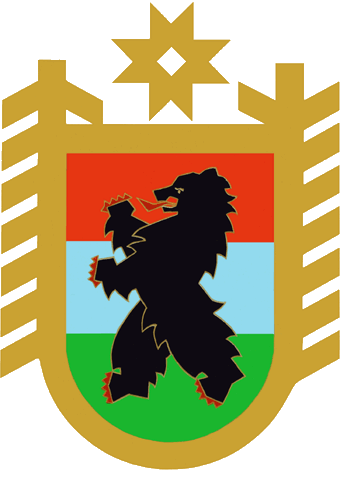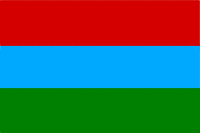 The Republic of Karelia is situated in the north-west of Russia and is included in The Northern Economic Region of the Russian Federation. The area of Karelia is 180.5 thousand square kilometers (1.06% of the total territory of Russia). The territory of the republic stretches out from the north to the south for 660 km. The extension from the west to the east in the latitude of the city of Kemi is 424 km.
The Republic of Karelia is situated in the north-west of Russia and is included in The Northern Economic Region of the Russian Federation. The area of Karelia is 180.5 thousand square kilometers (1.06% of the total territory of Russia). The territory of the republic stretches out from the north to the south for 660 km. The extension from the west to the east in the latitude of the city of Kemi is 424 km.
In the west Karelia borders upon Finland, in the south – upon Leningradskaya and Vologodskaya regions, in the north – upon Murmanskaya and in the east – upon Arkhangelskaya regions. In the northwest, the republic is washed by the White Sea. The western border of Karelia coincides with the frontier of the Russian Federation and its length is 726 km.
On the 1st of January 2005 the population of Republic Karelia was 703.1 thousand people (1939 - 468.9; 1979 - 732.1; 2000 - 765.1; 2002 - 716.7), with 75.5% living in cities and urban-type communities.
A third of the population lives in the capital city of the republic - Petrozavodsk. The population density of Karelia is 4 people per square kilometer.
The national structure of the population is the following: Russians – 76.6 per cent, Karelians – 9.2 per cent, Belorussians – 5.2 per cent, Ukrainians – 2.7 per cent, Finns – 2 per cent, Vepps – 0.75 per cent.
The republic includes 18 self-governing territories. Each self-governing territory is headed by a mayor, who is elected according to the Constitution of Karelia through direct secret voting. There are 3 cities of republican significance in Karelia (Petrozavodsk – 266.4 thousand people, Kostomuksha – 30.3 thousand people, Sortavala – 34.6 thousand people) and 15 regions.
Most part of the territory of the republic is an undulating plain with pronounced traces of glacier activity. The wavy surface of the land still holds traces of the ancient mountains. Karelia is often called a “stony lake-forest land”, which stresses the main elements of the landscape.
More than 49 per cent of the area is covered with forests (the main species are pine-tree and fir-tree), 25 per cent is water surface. There are more than 60 thousand lakes and 27 thousand rivers in Karelia. The largest are lake Ladoga (17.7 thousand sq.km.) and lake Onego (9.9 thousand sq. km.). The largest rivers are Vodla (400 km), Vyg, Kovda, Kemi, Suna and Shuja. The total length of the water chain is almost 83 thousand km.
More than 50 kinds of minerals are found in Karelia. The minerals are: iron ore, vanadium, molybdenum, rare metals, diamonds, mica, construction materials (granite, marble, diabase), clay, appatit-carbonate ore and asbestos.
The Republic of Karelia has a favourable economic and geographic location and huge mineral reserves. It is close to the central highly-industrialized regions of Russia and Western Europe. It also has a developed water-transport system.
 The Republic of Karelia has great opportunities for developing different types of tourism: hunting and fishing, guesthouses, spas during winter and summer season, rafting and ecological tourism. Karelia can satisfy the needs of all visitors: more than four thousand cultural, historical and natural monuments are on its territory.
The Republic of Karelia has great opportunities for developing different types of tourism: hunting and fishing, guesthouses, spas during winter and summer season, rafting and ecological tourism. Karelia can satisfy the needs of all visitors: more than four thousand cultural, historical and natural monuments are on its territory.
Karelia is one of the most famous Russian territories in international tourism for it's unique architectural, cultural and historical sites located on Kizhi, Valaam and Solovetskie islands, which are included in the UNESCO World Heritage List.
The historical and cultural peculiarity of Karelia, which differs it from the other regions of Russia, is made by the cultural heritage of it's four indigenous populations : Karelians, Finns, Russians and Vepps. Living together for more than ten centuries, they’ve created a unique and original culture.
Karelia is the birthplace of the famous Karelo-Finnish epos "Kalevala" - a literature monument of world significance. Here ancient Karelian and Vepps settlements, which are of great interest for the fans of ethnic tourism, are still kept protected.
Petroglyphs are more than five thousand years old. These are rock carvings created by ancient hunters and fishermen, samples of ancient written language and culture.
Annually in the end of July the largest in Russia Onego regatta of cruiser yachts is held on the Onego lake. It is a national championship of the sailing sport. Administrations of the regions of the northwest Russia work together to allow foreign sporty vessels to enter the territorial waters of the Russian Federation.
